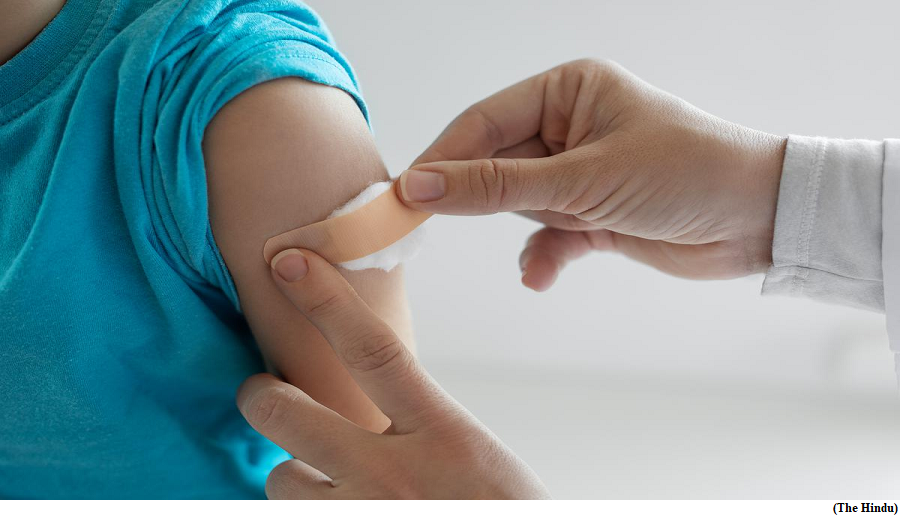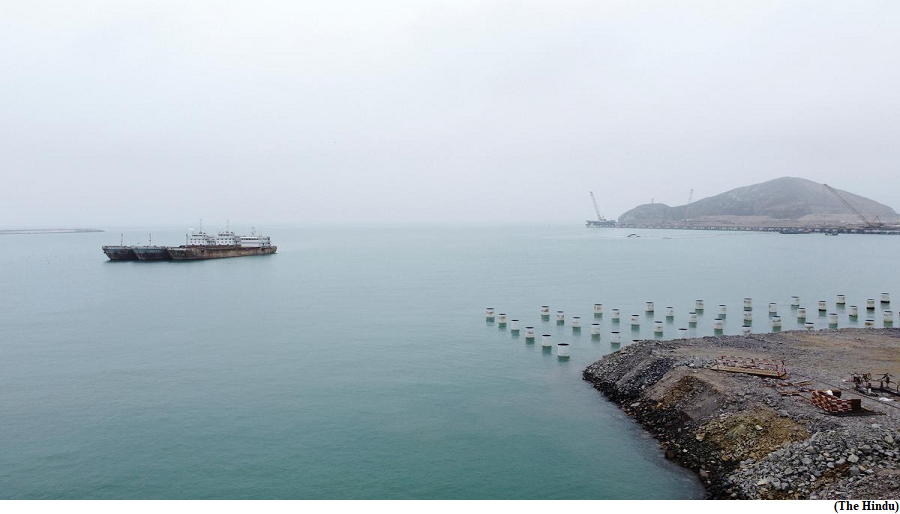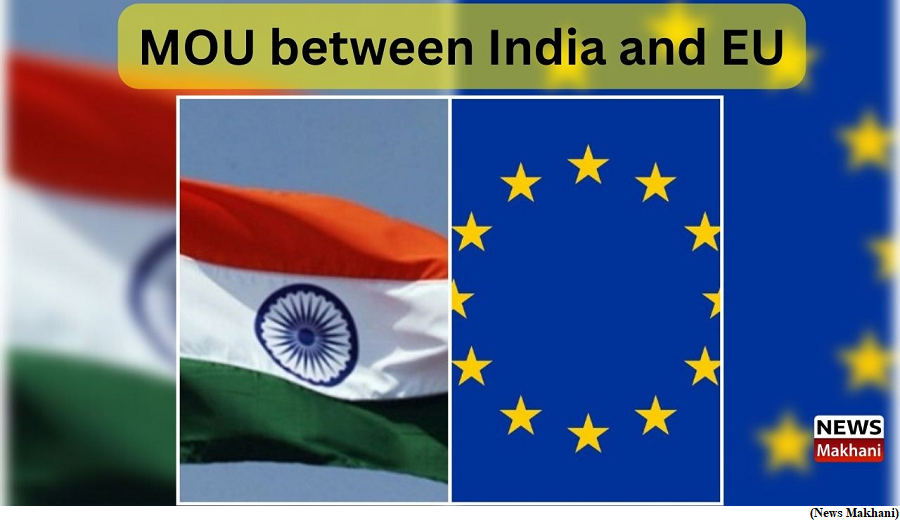The importance of periodic testing for human pappilomavirus (GS Paper 2, Health)

Context:
- January is Cervical Cancer Awareness Month.
What is Cervical cancer?
- Cervical cancer, which develops in a woman’s cervix (the entrance to the uterus from the vagina) is the second-most common cancer among women in India. It is caused by persistent infection by the human papillomavirus (HPV).
- Almost all sexually active people are infected by HPV at some point in their lives, but usually without symptoms, the World Health Organisation (WHO) states.
- In most people, the immune system clears up the virus. In some cases, certain high-risk strains of the virus persist in the body and could lead to cancer.
- India accounts for nearly a quarter of all cervical cancer deaths in the world. It is estimated that every year around 1.25 lakh women are diagnosed with cervical cancer, and nearly 75,000 of them die.
Eliminating cervical cancer:
- In 2022, the WHO adopted a strategy aimed at eliminating cervical cancer as a public health problem, worldwide.
- The strategy had three pillars; 90% of girls fully vaccinated by 2030 with the HPV vaccine, this to be done by age 15; 70% of women screened with a high-performance test between 35 and 45 for early treatment of pre-cancerous lesions, and 90% of women identified with cervical disease, to receive treatment.
What needs to be done?
- Though India is unlikely to meet the 2030 goals, the silver lining, is a decline in incidence.
- Despite not having a robust national screening or vaccination programme as yet, the number of cases are decreasing. This could be attributable to a number of factors including sexual hygiene, age of pregnancy and number of children, use of contraception and the immune status of individuals.
- There is need for a combination of awareness programmes, a vaccination programme and regular screening to prevent new cases and deaths. The goal should be to detect at the precancerous stage so they do not progress to full-blown cancer. At that stage, it is 100% curable.
Cervical cancer screening:
- Up until some years ago, the gold standard, world over, to screen for cervical cancer, used to be the pap smear. The pap smear involves the scraping and brushing of cells from the cervix. These cells are then examined.
- The smear is recommended every three years, for women between the ages of 25 and 65, barring high-risk groups, for whom the recommendation is once a year.
Issues with pap smear:
- The problem with the pap smear however is that it requires a cytologist to study the smear, and many places, especially in rural India, may not have access to the test itself, or to cytologists to study the samples.
- The second issue is that awareness continues to remain low, and even in urban areas where women come forward to do the test, it is difficult to get them to come back for follow-up screenings.
- As of 2019, the WHO says, fewer than one in 10 women in India had been screened in the previous five years.
HPV DNA testing:
- HPV DNA testing is the recommended method for screening for cervical cancer: this involves testing cells from the cervix for infections with any of the HPV types that could cause cancer.
- The WHO, too, recommends that HPV DNA testing be the first-choice screening method for cervical cancer prevention, these tests are less prone to quality problems and human errors.
Vaccine:
- The WHO’s Strategic Advisory Group of Experts on Immunization (SAGE) says that the HPV vaccine is highly effective for the prevention of HPV serotypes 16&18, which cause 70% of cervical cancers.
- In a recommendation in April 2022, SAGE stated that its review concluded that even a single-dose of HPV vaccine delivers solid protection against HPV that is comparable to two-dose schedules.
- The new SAGE recommendation is underpinned by concerns over the slow introduction of the HPV vaccine into immunisation programs and overall low population coverage, especially in poorer countries.
What are the government’s plans?
- There are currently two vaccines available in India that protect against the disease: Merck’s Gardasil and Serum Institute of India’s Cervavac.
- In 2018 Sikkim became the first State in the country to introduce the vaccine. The vaccine (Gardasil) was provided free, under the State budget. All girls aged between 9 and 14 years were given two doses, separated by six months. Coverage of the first and second rounds was reported at over 95%.
- In 2022, India’s National Technical Advisory Group on Immunisation (NTAGI) had recommended introducing the HPV vaccine in the country’s Universal Immunisation Programme (UIP). A one-time catch-up vaccine was to be provided for 9 to 14-year-old adolescent girls, and subsequently, with a routine introduction at nine years.
- Initially, reports had indicated that the Central government would roll out a vaccination programme in six states in June 2023, targeting girls between the ages of nine and 14, covering 2.55 crore girls. However, this did not materialise.
China widens trade highway in South America with new mega port project
(GS Paper 2, International Relation)
Why in news?
- A new Chinese mega port rising on the Pacific coast is promising to turbo charge South America’s trade ties with China.
- The $3.5 billion deep water port, set to start operations late in 2024, will provide China with a direct gateway to the resource-rich region.
- Over the last ten years, China has unseated the U.S. as the largest trade partner for South America, devouring its soy, corn and copper.

Chancay mega port:
- The port, majority-owned by Chinese state-owned firm Cosco Shipping, will be the first controlled by China in South America.
- It will able to accommodate the largest cargo ships, which can head directly to Asia, cutting the journey time by two weeks for some exporters.
- Beijing and Lima will become a regional hub, both for copper exports from the Andean nation as well as soy from western Brazil, which currently travels through the Panama Canal or skirts the Atlantic before steaming to China.
- The Chancay mega port aims to turn Peru into a strategic commercial and port hub between South America and Asia.
Part of ‘Belt and Road’ drive
- Part of China’s decade-old ‘Belt and Road’ drive, the new port embodies the challenge facing the U.S. and Europe as they look to counter China’s rising influence in Latin America.
- Some 150 countries have signed on to the Belt and Road with China, including 22 in Latin America.
- Full construction started in 2018 at Chancay, some 80 kilometre north of Lima. Workers are now laying thousands of piles and breakwaters; work signs are written in white-on-red Chinese characters.
- The first phase of Chancay is set be completed in November 2024. Chinese President Xi Jinping, expected in Peru for an Asia-Pacific Economic Cooperation (APEC) summit that month, could inaugurate the port.
- Peru’s government is planning an exclusive economic zone near the port and Cosco wants to build an industrial hub near Chancay to process raw materials that could include grains and meat from Brazil before shipping them to Asia.
What it holds for China?
- Fast-growing China needs the copper and lithium from South America’s Andes, along with the corn and soy from the plains of Argentina and Brazil.
- But its widening trade lead, some $100 billion around South America in the most recent annual data brings extra clout.
- China has in 2023 upgraded ties with Uruguay and Colombia to “strategic partnerships”, the latter a U.S. ally.
Semiconductors Ecosystems under EU India Trade and Technology Council
(GS Paper 3, Science and Technology)
Why in news?
- Recently, the Union Cabinet was apprised of a Memorandum of Understanding (MoU) between India and the European Commission on Working Arrangements on Semiconductors Ecosystems, its supply chain and innovation under the framework of EU-India Trade and Technology Council (TTC).

Details:
- The MoU intends to strengthen cooperation between India and EU towards enhancement of semiconductor for the advancement of Industries and digital technologies.
Implementation strategy and targets:
- The MoU shall come into effect from the date of signature and may continue until both sides confirm that the objectives of this instrument have been achieved or until one side discontinues its participation in this instrument.
Impact:
- Both G2G and B2B bilateral Cooperation to boost the resilience of the semiconductor supply chains and leverage complementary strengths to promote collaboration in the field of semiconductors.
Background
- MeitY has been actively working to create a conducive environment for electronics manufacturing. Programme for Development of Semiconductor and Display Manufacturing Ecosystem in India was introduced with a view to ensure the development of a robust and sustainable semiconductor and display ecosystem in India.
- The said program aims to extend fiscal support for establishment of Semiconductor Fabs, Display Fabs, Fabs for Compound Semiconductors/Silicon Photonics/Sensors/Discrete Semiconductors and Semiconductor Assembly, Testing, Marking, and Packaging (ATMP)/Outsourced Semiconductor Assembly and Test (OSAT) facilities.
- Further, India Semiconductor Mission (ISM) has been established under Digital India Corporation (DIC) to drive India’s strategies for development of semiconductor and display manufacturing ecosystem in the country.
- MeitY has also been mandated to promote international cooperation in the emerging and frontier areas of Electronics and Information Technology under bilateral and regional frameworks.
- With this objective, MeitY has entered into MoUs/MoCs/Agreements with counterpart organizations/agencies of various countries to promote bilateral cooperation and exchange of information and also to ensure supply chain resilience enabling India emerge as trusted partner.
Way Forward:
- This MoU is another step towards mutually beneficial semiconductor related business opportunities and partnerships between India & EU.




![]()